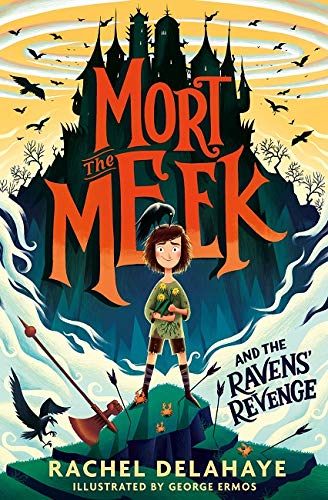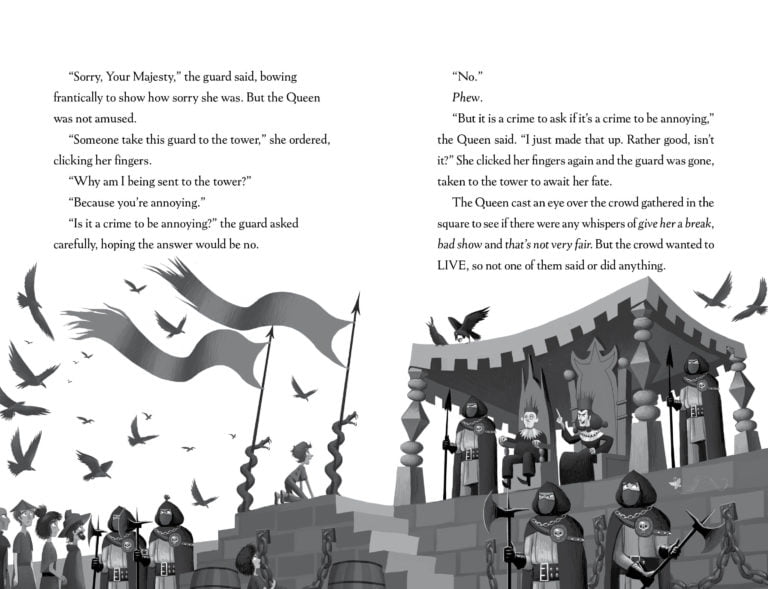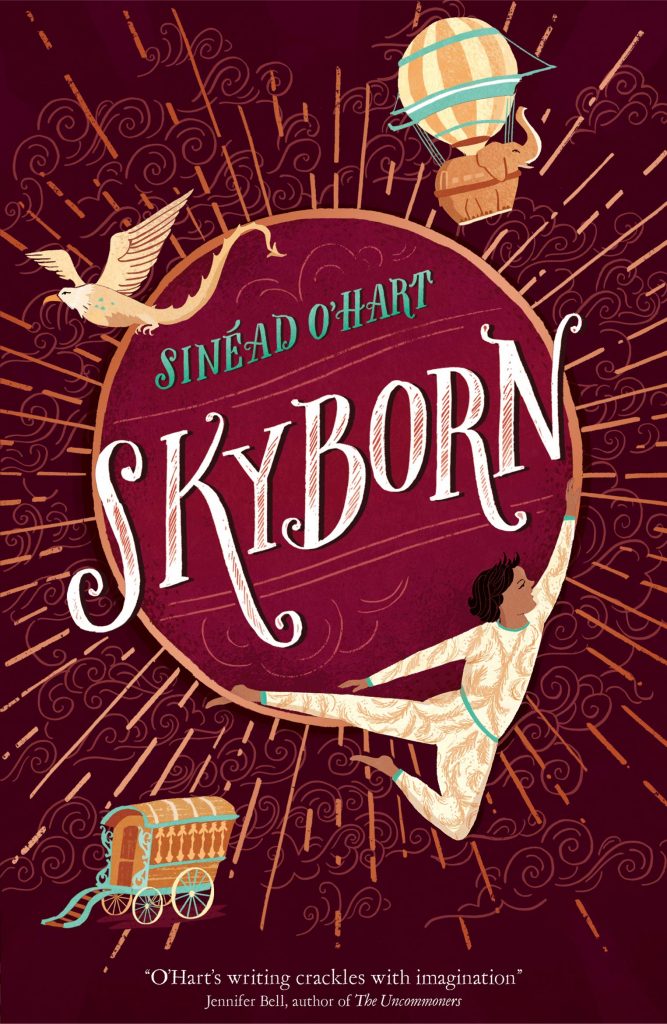Today we welcome Rachel Delahaye into #TheRealm to talk about her laugh-out-loud children’s book Mort the Meet and the Ravens’ Revenge, which is illustrated by George Ermos and published by Little Tiger!
Firstly, welcome to The Reading Realm! I wondered if we could start with you introducing yourself and telling us about Mort the Meek and the Ravens‘ Revenge!
Hi, I’m a long-haired writer from the world of what-the! Or that’s how I see myself, as my brain spends a large proportion of the day in made-up lands with incredible creatures, ridiculous landscapes and unlikely heroes. My latest book is Mort the Meek and the Ravens’ Revenge (illustrated by the incredible George Ermos). It’s about a boy who lives on an awful, violent island called Brutalia where people thump each other for no reason and life is generally very unpleasant. Mort is the island’s only pacifist and dreams of kindness, but when he gets made Chief Executioner, he has to find a way to twist his fate and fight for peace. It’s a comedy, you’ll be relieved to hear. Pure, silly, slightly revolting comedy. I wrote another series with dark, comic themes called Jim Reaper, about a boy who is the son of Death… My children beg me to stop writing weird stuff, but I won’t. I just won’t.
What are the main themes in Mort the Meek and the Ravens’ Revenge?
I’ve had my books compared to Pratchett (I am not worthy) and Andy Stanton (I am not worthy). I think this is because, in the first place, I build worlds which are quite fantastical, but also richly detailed enough that you could believe they exist, even just for second. But my worlds and characters don’t take themselves too seriously. Comedy allows us to shine a light on the dark side of humour nature and our most revolting behaviours and then laugh at them, to dispel any scariness and also to expose just what a silly species we can be sometimes. As for likening my books to Andy Stanton’s writing… Well, it’s no secret that I am a huge fan of his. His writing is so surreal; it’s like putting a story through all the machines in a sweet factory, so it comes out twisted, fizzy and colourful with a peculiar flavour. I do try to do something similar, perhaps with different ingredients and a slightly different process, but much of my writing is stream of consciousness, meaning I don’t plot it out in detail. What comes out won’t be to everyone’s taste, but I certainly hope it’s interesting and a little different.

What was your journey like to getting an agent and publisher?
I started writing years before I got an agent, for myself and for my children. But it wasn’t until I wrote Jim Reaper that I wondered if I might get it published the traditional way. I approached several agents from various agencies, but I was extraordinarily lucky in that the one I was hoping for – David Higham Associates – got back to me. My father had been one of their clients once upon a time, and I thought it would be nice to be in the same stable. I was actually approached by another agent at the same time, but when I met Alice from DHA (she has since started her own agency, Alice Williams Literary), her enthusiasm was infectious. She didn’t just want to discuss Jim Reaper, she wanted to find out about all my ideas. I felt that she would not just help me get Jim Reaper published, she’d help me establish a career in writing, which was/is my dream. And I think we just felt right for each other. Following that major step on the ladder, the next was to find a publisher for Jim Reaper. It wasn’t instant. I think it took six months for an editor to see the potential in my first draft… That was Matilda Johnson, then at Piccadilly Press. Thank goodness she did.
What does a day in your life look like when you are working on your children’s books?
My days are all the same in some ways and all different in others. I start, after a dog walk, at 9.30am and then sit for several hours at my desk, wondering what will happen. Sometimes, I’ll do an entire day on social media, connecting with other authors and editors or just having fun; or I might sort out my files and look at book ideas I’ve jotted down; some days I’ll write from start to finish. When I really get in the writing mood, I go into hyper-focus, which means I will write and write and I won’t stop until I run out or energy or words. Hyper-focus days are rare, but that’s when ‘the magic happens’– the thrill of having a story that is bursting to get out is the greatest joy.
What is the editing process like for you? What does it involve? What did you have to edit out of this book to make it work?
My editing process is usually painful. I love writing, but I always do so in a rush of enthusiasm, which means that inevitably I’ll need to go back and restructure or rethink elements of the story. Restructuring is like undoing a jigsaw puzzle, then redoing it with more or fewer pieces… It can be extremely frustrating and time-consuming. It’s always a really good idea for me to step back and take a breath and return to the task when my absolute fiery undying love for the original draft has cooled a little. Fiddling with a story when it’s still on fire is too painful. Sometimes I’ll ask someone else to read it – my agent or a friend – as fresh eyes can locate the trouble spots, and ultimately, the reader’s opinion is the most valid.
What’s the best thing about being a children’s author?
On any given day, I can be writing about animals, or exotic islands, or magic and mayhem. Life is so varied and I get to reflect that. Best of all, it forces me to find the wonder in our world, and put reactions and emotions into words and explain things in the simplest of terms, which is sometimes very hard to do. It’s a discipline, but also an absolute joy. Being a children’s author isn’t easy, but it’s incredibly rewarding, and in a way, it means I never have to grow up. I can revisit the things that awed me when I was a child, and I can repackage that nostalgia for a new generation. It’s an honour and I feel lucky, every single day.

Did you have a favourite story when you were younger?
I didn’t have a single favourite, but I loved the Dark is Rising series by Susan Cooper, which blends mystery, myth and magic. The good versus evil theme is so powerful; stir in magic – something I think most children would like to possess and master – and you have a fantasy that’s gripping and immersive. I think that’s why Harry Potter is so successful. It is fun, magical and aspirational, but with a nightmarish undercurrent that makes the heart beat faster and pulls us from our comfort zone. And I think most of us like that – treading the fine line between light and dark. In books, we can do that safely.
What advice would you give to teachers about how to develop reading for pleasure in their classrooms and schools?
I think there should be less focus on books as solid items. Read a book. What does that actually mean? A straight-forward instruction, even with a happy voice, isn’t going to inspire. I think teachers should, and most probably do, talk about stories and characters. Why not build up a character – description, strengths, weaknesses, back story, ambition – and then send children on a mission, into the book, to find out what happens to that character or how s/he acts? Set treasure hunts for children – details to pick up in the story – or even get them to compare a scene in a book with its related scene in a film. Some children take to books like ducks to water, but others need a helping hand to open the cover and see that between the rows of black and white symbols there is world of colour, of excitement, friendship and revelation, all waiting to be discovered. It’s not ‘a book’. It’s a portal.
How would you envisage teachers using your book in their classrooms? What age group is it aimed at? Do any activities or ideas spring to mind?
Mort the Meek is aimed at middle-grade – ages 8-12 – and I think it’s a great jump off point for discussions about empathy and self-conviction. Mort is essentially an illustration that you don’t have to do what’s expected of you. He is born on an island where everyone hurts each other, but despite the pressures of his upbringing and the conditioned behaviour of the people around him, he knows it doesn’t have to be that way. The Reader Teacher, Scott Evans, has created some great free teaching resources (link below) and activities for Mort, but in addition to those, I would suggest acting out scenarios of bullying and explore ways to diffuse it, or perhaps look at superhero versus villain combats and discuss how Mort the Pacifist might have delt with the situation. Essentially, if Mort’s story could be used to show how the non-aggressor or the problem solver can be the hero and the playground inspiration, then that would make me very happy indeed.
There are also some teaching resources here!
Can you recommend a book you’ve enjoyed recently and one you’re looking forward to?
I’ve just read Skyborn by Sinead O’Hart, which is coming out soon – the story of a circus boy in possession of something that belongs to a creature from a different world. I love Sinead’s writing (The Eye of the North, The Star-Spun Web) – it’s so full of detail and atmosphere, and yet it races along. It feels as if you’re right inside the story. It’s like Dickens on rollerskates, with added magic.

What’s one thing you would like your readers to know Mort the Meek and the Ravens’ Revenge?
Humour is your suit of armour.

